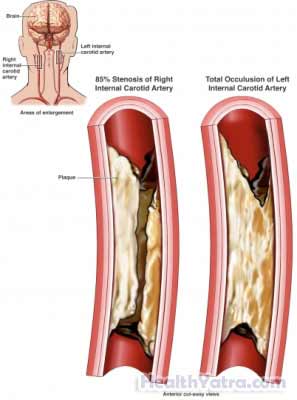Definition
Atherosclerosis is hardening of a blood vessel from a build up of plaque. Plaque is made of fatty deposits, cholesterol, and calcium. It builds on the inside lining of arteries. This causes the artery to narrow and harden. As plaque builds up, it can slow and even stop blood flow.
Endarterectomy is a surgery to remove this build-up and improve blood flow. Surgery is most often performed on:
- Carotid arteries in the neck that supply the brain—most common use of endarterectomy
- The aorta—a major artery that runs from the heart to the abdomen
- Iliac and femoral arteries of the legs
- Renal arteries that supply the kidneys with blood

Reasons for Procedure
This surgery is done to remove the build-up of deposits and improve blood flow. After the surgery, the symptoms of reduced blood flow, such as stroke, digestive problems, and leg cramps should improve.
Possible Complications
If you are planning to have endarterectomy, your doctor will review a list of possible complications, which may include:
- Bleeding
- Stroke, particularly if the carotid arteries are involved
- Blood clots
- Adverse reaction to the anesthesia
- Infection
Some factors that may increase the risk of complications include:
- Smoking
- Poor overall health
- Increased age
- Plaque build-up in other vessels
- Other serious diseases, such as heart failure, uncontrolled high blood pressure,diabetes, cancer, and kidney disease
Be sure to discuss these risks with your doctor before the procedure.
What to Expect
Prior to Procedure
Before the surgery, your doctor will:
- Give you an exam to make sure that you are healthy enough for the surgery
- Order studies that show detailed images of your arteries
Talk to your doctor about your medicines. You may be asked to stop taking some medicines up to one week before the procedure, like:
- Anti-inflammatory drugs
- Blood thinners
In addition, you may be instructed to:
- Avoid eating or drinking after midnight the night before the surgery.
- Arrange for a ride home from the hospital.
Anesthesia
You may have:
- General anesthesia —blocks any pain and keeps you asleep through the surgery; given through an IV in your hand or arm
- Local anesthesia—numbs an area of your body so that you stay awake through the surgery; may be given as an injection
Description of the Procedure
Incisions will be made over the diseased part of the artery. The location will depend on the artery that is being unblocked.
In the abdomen and legs, the doctor will clamp the artery above the obstruction during the repair. The lower half of the body can go without blood supply during the time it takes to do the surgery. If surgery is done on the neck, the blood around the surgical site may first be rerouted. This will keep blood going to the brain.
The inside of the artery will be cleaned out. Care will be taken not to have small fragments of the deposits break off and flow downstream, causing stroke or arterial occlusion. After the artery is cleaned out, the artery and the skin will be closed with sutures or staples.
How Long Will It Take?
Several hours, depending on the severity of the disease
How Much Will It Hurt?
After surgery, there will be pain from the incisions. Ask your doctor about medicine to help reduce discomfort.
Average Hospital Stay
This procedure is done in a hospital setting. The usual length of stay is one day to one week. Your doctor may choose to keep you longer if complications occur.
Post-procedure Care
At the Hospital
While you are recovering at the hospital, you may receive the following care:
- You will be monitored to make sure that you are not bleeding, clotting, or developing an infection.
- You will also be monitored to make sure that your wound is healing properly and that your pain is managed.
At Home
When you return home, do the following to help ensure a smooth recovery:
- Have your sutures or staples removed when instructed.
- If advised by your doctor, take blood thinners.
- If you had abdominal surgery, gradually resume your normal eating habits.
- To help reduce the risk of plaque build-up, make changes to your diet, such as eating a diet:
- Low in saturated fat
- High in fruits and vegetables
- High in grains and fish
- If advised by your doctor, work with a nutritionist.
- Ask your doctor about when it is safe to shower, bathe, or soak in water.
- Be sure to follow your doctor’s instructions .
Call Your Doctor
After you leave the hospital, contact your doctor if any of the following occurs:
- Signs of infection, including fever and chills
- Redness, swelling, increasing pain, excessive bleeding, or any discharge from the incision site
- Nausea and/or vomiting that you cannot control with the medicines you were given after surgery, or which persist for more than two days after discharge from the hospital
- Pain that you cannot control with the medicines you have been given
- Constipation or diarrhea
- Inability to urinate
- Lightheadedness
- Severe headaches
- Problems with speech or vision
- Cough, shortness of breath, or chest pain
In case of an emergency, call for medical help right away.
